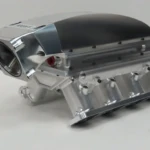The Power of Precision: The Ultimate Guide to 4×4 CNC Machine Tools
For manufacturers, hobbyists and prototyping shops, CNC (computer numerical control) technology has revolutionized the manufacturing process. But when a project requires the use of relatively large, flat materials without the sheer scale of an industrial giant, 4×4 CNC machine tools become the ideal solution. Versatile, easy to use, and powerful, these machines occupy an important place in the world of computer-controlled machining. Let’s dive into what makes them indispensable and how GreatLight leverages advanced expertise to maximize their capabilities.
What exactly is a 4×4 CNC machine?
Essentially, the definition of a 4×4 CNC machine is 32 sq. ft. work area (4ft wide x 4ft long – approximately 1200mm x 1200mm). Although most commonly CNC milling machines, it can also include milling machines with this bed size. They use G-code programming to turn digital designs into precise cutting, drilling, engraving or engraving operations in materials ranging from wood and plastic to softer metals like aluminum. They operate along three axes (X, Y, Z), specialize in 2.5D machining (contouring and pocketing), and can produce complex flat parts and complex contours.
Why choose 4×4 format? Main advantages
- Best sizes for common materials: 4×4 sheets are a standard size for plywood, MDF, acrylic, and many plastics. This bed size minimizes waste while maximizing the area available for parts.
- Space efficiency: They can be easily installed into workshops, garages, small factories or educational environments, providing a spacious work area without requiring a lot of space like larger 5×10 or 8×4 machines.
- Powerful abilities: Modern 4×4 CNC is not a toy. With powerful spindles (typically 3-5 HP and above), rigid frames (steel or epoxy granite), and high-precision linear guides/ball screws, they can handle demanding tasks. Many people can machine aluminum parts efficiently, especially using specialized equipment.
- Cost effectiveness: A significant leap in capabilities compared to small desktop machines, 4×4 CNCs cost significantly less than larger industrial equipment, providing an excellent return on investment. Mass production and diverse low-volume prototyping become economically feasible.
- Versatility and software compatibility: Their applications range from making complex furniture components and signage to prototyping functional mechanical parts or cutting decorative panels. They integrate seamlessly with industry-standard CAD/CAM software (AutoCAD, Fusion 360, Vectric).
Material issues: What can they handle?
Although usually associated with wood and plastic, a well-built 4×4 CNC router or router can significantly expand its horizons:
- Soft metal: Aluminum is the best example. Reliable machining can be achieved with the right tool (single or multi-edge end mill), feed/speed, and the potential for mist or flooded coolant.
- Nonferrous metals: Brass, copper and tool plates can be machined efficiently.
- Composite materials: Carbon fiber board, fiberglass board, G10.
- Foam plastic: Rigid foam (XPS), HDPE, UHMW PE for models and prototypes.
- Heritage Materials: Solid wood, plywood, MDF, veneer.
IMPORTANT NOTE: For the production of hardened steel, titanium or extremely high-volume ferrous metals, larger dedicated milling centers or 5-axis machines are required.
Gretel: CNC accuracy has improved beyond expectations
While 4×4 machines are the basic workhorse, GreatLight’s core expertise Advanced five-axis CNC machining Even before you buy or use a 3-axis work center, it brings unique value:
- Precision engineering genes: Our mastery of ultra-precision, complex 5-axis machining means we understand sub-0.001" Basically, it’s tolerance control, thermal stability and vibration damping. This philosophy is reflected in the robust design of the CNC solutions we offer.
- One-stop complex manufacturing: Requires aluminum brackets or critical components For your own 4×4 CNC machine? Or complex clamps and fixtures to enhance its functionality? GreatLight uses advanced equipment to efficiently produce these precision metal parts, ensuring they function flawlessly within your 4×4 ecosystem.
- Beyond 4×4 limitations: When projects require true 3D contours, part geometries that require undercuts, or five-sided machining in one setup, production times can be significantly reduced and accuracy increased – this is where GreatLight’s 5-axis services become indispensable. When your project exceeds the scope of a 4×4 or its 3-axis kinematics, we bridge the gap.
- Excellent post-processing: Whether it’s a part machined on a 4×4 CNC or an assembly we supply via 5-axis machining, GreatLight can provide seamless finishing: precision anodizing, powder coating, polishing, heat treatment or any other necessary surface enhancement.
Choosing the right 4×4 CNC: key factors
Choosing the best machine requires careful consideration:
- Frame stiffness: Steel gantry and base perform significantly better than lighter aluminum extrusions in terms of vibration control and precision in harder materials.
- Spindle power and torque: Key to clean cuts, especially in aluminum and hard woods (for aluminum, at least 3HP recommended; 5HP+ preferred for professional use).
- Drive system: Ball screws on all axes ensure greater accuracy, better repeatability and longer service life than the rack and pinion systems commonly found in lower-cost models.
- Control system: Well-known brands (Syntec, Rich Auto, Centroid, LinuxCNC) offer smoother operation, more features and better reliability.
- Dust removal: Essential for health and machine life. Ensure compatibility with efficient extraction.
- Support and service: Evaluate the manufacturer’s reputation for technical support, warranty, spare parts availability, and documentation.
Conclusion: Unleash your potential with the right tools and expertise
4×4 CNC machines represent the best option for countless shops: powerful enough to achieve professional results with a variety of materials, yet suitable for an accessible workshop. Its ability to transform standard panels into complex assemblies provides tremendous flexibility. Whether you are starting small-scale production, making custom furniture or developing prototypes, the powerful 4×4 CNC unlocks huge potential.
However, keep in mind that complex geometries or ultra-high-precision metal parts may require upgrading to advanced multi-axis machining. huge light Ready to be your expert partner on this continuum. Not only do we understand the complexities of 3-axis work, we have cutting-edge technology (true 5-axis CNC) and an experienced engineering team to handle boundary-pushing projects. From providing custom parts for your equipment to providing the complex multi-sided machining your project requires, coupled with our comprehensive finishing services, we offer a true one-stop precision manufacturing solution.
Ready to experience the difference high-precision machining makes, whether integrating with your 4×4 setup or tackling complex five-axis challenges? Visit GreatLight today to explore your custom precision parts options and get a competitive quote.
Frequently Asked Questions about 4×4 CNC Machine Tools
-
Q: What is the difference between a 4×4 CNC mill and a milling machine?
one: router: Specializes in softer materials (wood, plastic), typically using high speed spindles (e.g. 20,000+ RPM), lighter frames. For flat goods it is usually faster.
Mills: Designed specifically for metal, using a variable speed spindle with high torque at lower RPM (e.g. 0-6000 RPM). Featuring an extremely strong frame, ball screws and tighter tolerances. Some "Milling capability" The 4×4 router effectively bridges the aluminum gap. -
Q: Can 4×4 CNC machine be used? Carter steel?
one: Generally speaking, Nosuitable for standard structure types. Cutting ferrous steel (especially the harder grades) requires an extremely strong frame, very high spindle torque at low rpm, a strong toolholder and a lot of power (typically 7.5HP+), which are characteristics of an industrial mill rather than a typical 4×4 mill. With the proper setup and tools, they can effectively machine softer metals like aluminum. -
Q: Is a vacuum workbench necessary?
one: Highly recommended for increased efficiency and security, especially For sheet goods. The vacuum table holds large flat material workpieces quickly and evenly over the entire surface, providing excellent hold down without the clamps interfering with the tool path. A T-slot table with clamps is a common alternative, but is less efficient for processing the entire sheet. -
Q: How much power (electricity) do they need?
one: Most professional 4×4 CNCs require a lot of power. A minimum of 240V single-phase power is common, with high-end models (especially those for metal) often requiring 240V three-phase power. Check specific machine requirements! Power under load is typically 3kW to 10kW. -
Q: What level of accuracy and tolerance can I expect?
one: A well-built industrial grade 4×4 CNC can often achieve ±0.001" to ±0.005" (0.025 mm to 0.127 mm) positioning accuracy with good repeatability across the work area. Router type may be closer to ±0.005" For complex paths, rigid ball screw driven milling machines can achieve better results. Factors such as material stability and tool deflection also affect tolerance maintenance. -
Q: Does cutting aluminum require cooling?
Answer: Definitely recommended. Cutting aluminum can generate a lot of heat, which can damage tools and workpieces. A mist coolant system (air + liquid mist) or flood coolant (if your machine supports the housing) can significantly improve tool life, surface finish, chip evacuation and dimensional control. -
Q: How long does it take to learn CNC programming?
one: The learning curve varies. Able to master basic 2D cutting operations using CAM software integrated with commonly used tools days to weeks. Proficient in creating efficient, complex 3D tool paths and optimizing feed/speed needs for different materials months of practice. Software usability plays a big role – some software packages are more intuitive than others. - Q: If I own a 4×4 machine, where does GreatLight’s 5-axis CNC service apply?
one: Think of them as complementary solutions. use your 4×4 CNC lathe Suitable for productive projects: sign making, carpentry, flat aluminum brackets, 2.5D panels. Partners huge light for: Complex metal parts Requires 5 sides of processing, Complex 3D contours Not possible on 3 axes, Ultra-high precision components (±0.0005"), low volume Special metal parts requiring professional surface treatment. We seamlessly fill the gaps your 4×4 machine can’t handle.









































